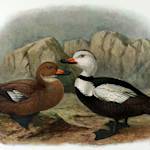Red Knots and Horseshoe Crabs
1990s - 2022 CE
"The red knot was once the most numerous shorebird in North America. A century ago, market hunting decimated the red knot's population and despite a massive drop in hunting today they are vanishing faster than ever before. In spring, migrating red knots stop at the Delaware Bay to refuel on the eggs of horseshoe crabs. They eat as many as 24,000 eggs per day, doubling their weight within two weeks. But horseshoe crabs are harvested as bait for conch and eel. "Since the 1990s, over-harvesting of horseshoe crabs has caused the supply of eggs to plummet and red knot numbers in Delaware Bay have declined from a high of more than 100,000 birds in the 1980s to fewer than 15,000 today." If overharvesting continues the red knot may become extinct as early as 2010."
WHAT YOU CAN DO
Help support limits on horseshoe crab harvesting.
FOR MORE INFORMATION
Visit New Jersey Audubon, the Monterey Bay Aquarium and Conserve Wildlife.
Macaulay Library, Cornell Lab of Ornithology


Learn about Maya Lin’s fifth and final memorial: a multi-platform science based artwork that presents an ecological history of our world - past, present, and future.

Discover ecological histories and stories of former abundance, loss, and recovery on the map of memory.

Learn how we can reduce our emissions and protect and restore species and habitats – around the world.

See how art can help us rethink the problems we face, and give us hope that each one of us can make a difference.

Help make a global memorial something personal and close to home. Share your stories of the natural world.


